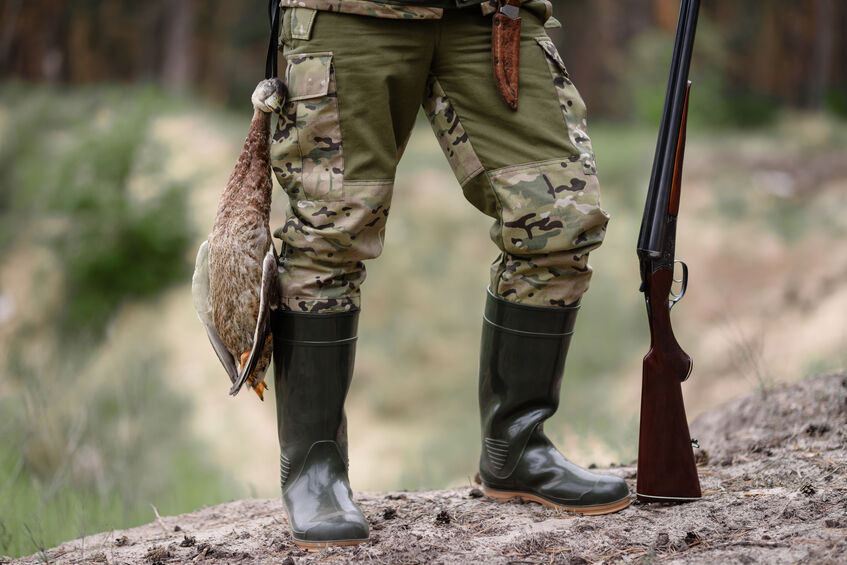To waterproof hunting boots, apply a waterproofing spray or wax, making sure to cover the entire surface of the boots. Additionally, pay extra attention to seams and stitching to ensure complete protection against moisture.

Credit: www.tiogaboarhunting.com
Table of Contents
Importance Of Waterproofing Hunting Boots
Waterproofing hunting boots is crucial for outdoor enthusiasts. Protect your feet from moisture and stay comfortable in any weather condition with these simple tips for waterproofing your boots.
When it comes to hunting, having the right gear is essential. One crucial gear item that often gets overlooked is hunting boots. Many hunters underestimate the importance of waterproofing hunting boots, but it can make a significant difference in your overall comfort and hunting experience.
Waterproofing your boots not only protects your feet from getting wet in soggy or rainy conditions but also plays a crucial role in extending the lifespan of your boots. Let’s delve deeper into the significance of waterproofing hunting boots.
Protecting Your Feet In Wet Conditions
- Waterproof hunting boots can keep your feet dry, even in the wettest conditions. This directly contributes to your overall comfort while hunting, as wet feet can become painful and lead to blisters and discomfort.
- Moisture can also easily seep through non-waterproof boots, making your feet cold and increasing the risk of frostbite in extreme weather conditions. Waterproofing hunting boots creates a barrier that prevents moisture from entering and keeps your feet warm and protected.
- Wet and cold feet can also affect your balance and stability, making it difficult to navigate the terrain and potentially compromising your hunting success. Waterproof boots provide the necessary traction and support to keep you balanced and steady on your feet.
Extending The Lifespan Of Your Boots
- By investing time to waterproof your hunting boots, you can significantly extend their lifespan. Moisture can cause leather boots to degrade, leading to cracks, peeling, and weakening of the material. Waterproofing prevents water from penetrating the boots, thereby preserving their integrity and durability.
- Additionally, waterproofing your boots can protect them from other external factors, such as mud, dirt, and debris. These elements can not only make your boots dirty but also damage them over time. Waterproofing acts as a shield against these elements, ensuring your boots stay cleaner for longer.
- Regularly waterproofing your hunting boots also helps maintain their breathability. Breathable boots allow moisture to escape while preventing water from entering. This feature enhances comfort by reducing excessive sweating and potential foot odor.
Waterproofing your hunting boots is a simple yet crucial step to enhance your hunting experience. It not only protects your feet in wet conditions but also extends the lifespan of your boots. By investing a little time into waterproofing, you can ensure your boots remain comfortable, durable, and ready for your next hunting adventure.
Understanding The Materials Used In Hunting Boots
Understanding the materials used in hunting boots is crucial for hunters who want to keep their feet dry during wet hunting conditions. Learn how to waterproof your hunting boots to ensure maximum protection while out in the field.
When it comes to selecting the best waterproof hunting boots, understanding the materials used is crucial. The right materials can make all the difference in keeping your feet dry and comfortable during hunting expeditions. Here are the types of boot materials commonly used and the factors to consider when choosing them:
Types Of Boot Materials Commonly Used
- Leather: Leather is a popular choice for hunting boots due to its durability and water resistance. It offers excellent protection against moisture but may require periodic treatment to maintain its waterproof properties.
- Synthetic fabrics: Many hunting boots incorporate synthetic materials such as nylon, polyester, or GORE-TEX. These fabrics are lightweight, breathable, and offer superior water resistance. They are often combined with other materials for optimal performance.
- Rubber: Rubber boots are highly waterproof and provide excellent protection in wet and muddy environments. They are easy to clean and maintain, making them a go-to option for many hunters.
- Insulation: While not a specific material itself, insulation plays a crucial role in keeping your feet warm and dry. Thinsulate and other synthetic insulation materials are commonly used in hunting boots to provide warmth without adding bulk.
Factors To Consider When Choosing Materials For Waterproofing
- Waterproof rating: Different materials have varying levels of waterproofness. Look for boots with a high waterproof rating to ensure optimal protection against moisture. GORE-TEX and similar technologies are known for their exceptional waterproof properties.
- Breathability: While waterproofing is essential, good breathability is equally important to prevent sweat buildup and keep your feet comfortable. Look for materials that offer a balance between waterproofness and breathability, allowing moisture to escape while keeping water out.
- Durability: Hunting boots are subjected to rough terrains and harsh conditions, so choosing durable materials is crucial. Opt for high-quality leather or tough synthetic fabrics that can withstand the rigors of hunting.
- Weight: The weight of your hunting boots can significantly impact your mobility and comfort in the field. Consider materials that are lightweight without compromising on durability and waterproofness.
- Insulation properties: If you hunt in colder climates, insulation becomes a key factor to consider. Look for boots with appropriate insulation materials and insulation ratings to ensure your feet stay warm in chilly conditions.
Remember, the right combination of materials can maximize the waterproofing capabilities of your hunting boots. Consider your specific hunting needs and preferences when choosing the materials that best suit your requirements. With proper care and maintenance, well-designed hunting boots made from quality materials can provide years of reliable waterproof performance, keeping your feet dry and comfortable no matter the weather conditions.
Preparing Your Boots For Waterproofing
Get your hunting boots ready for the outdoors by following these simple steps to waterproof them. Protect your feet from wet and muddy conditions and ensure a comfortable hunting experience.
Cleaning The Boots Thoroughly:
To prepare your hunting boots for waterproofing, it’s essential to start with a thorough cleaning. This will ensure that the waterproofing product adheres properly and maximizes its effectiveness. Here are the steps to clean your boots:
- Start by removing the laces and shaking out any loose dirt or debris.
- Use a soft brush or cloth to gently scrub the boots, paying special attention to the areas where dirt and grime accumulate, such as the soles and seams.
- If there are any stubborn stains, you can use a mild detergent or specialized boot cleaner. Apply a small amount and scrub gently.
- Rinse the boots with clean water to remove any soap residue.
- Use a towel or cloth to pat dry the boots, removing any excess moisture.
Now that your hunting boots are clean, it’s time to move on to the next step.
Removing Dirt And Debris:
Before applying any waterproofing product, it’s crucial to ensure that your boots are free from dirt and debris. Here’s how you can clean your boots thoroughly:
- Start by inspecting the boots for any visible dirt, mud, or debris.
- Use a soft-bristled brush or an old toothbrush to gently brush away any loose dirt and debris from the surface and the seams.
- Pay extra attention to the tread pattern and hard-to-reach areas. Make sure to remove all the dirt and debris accumulated in these spots.
- If there are any deep-seated stains, you can use a damp cloth and mild soap to clean them gently.
- Once you’ve removed all the dirt and debris, rinse the boots with clean water and pat them dry with a towel or cloth.
With the dirt and debris removed, your boots are now ready for the next step.
Ensuring The Boots Are Dry Before Starting The Process:
Before you begin the waterproofing process, it’s crucial to ensure that your hunting boots are completely dry. Waterproofing products won’t adhere properly to wet surfaces, reducing their effectiveness. Follow these steps to make sure your boots are dry:
- After cleaning your boots, leave them in a well-ventilated area to air dry naturally. Avoid direct sunlight or using external heat sources like hair dryers, as these can damage the boots.
- Stuff the boots with crumpled newspaper or paper towels to absorb any remaining moisture. This will help speed up the drying process.
- Leave the boots to dry for at least 24 hours or until they are completely dry to the touch.
- Check the insides of the boots as well to ensure there is no moisture trapped, as this can lead to discomfort during your hunting trips.
Once your boots are thoroughly dry, you can proceed with the waterproofing process.
Applying Waterproofing Products
Waterproofing hunting boots is essential for outdoor enthusiasts. Protect your feet from moisture, using effective waterproofing products that ensure durability and long-lasting comfort in challenging terrains.
Choosing The Right Waterproofing Product
When it comes to choosing the right waterproofing product for your hunting boots, it’s important to consider a few factors. Here are some key points to keep in mind:
- Material compatibility: Ensure that the waterproofing product is compatible with the material of your boots. Different types of materials require different waterproofing solutions.
- Breathability maintenance: Look for a waterproofing product that allows your boots to breathe. This will help prevent moisture buildup inside the boots, keeping your feet dry and comfortable.
- Long-lasting protection: Opt for a waterproofing product that provides long-lasting protection, especially if you frequently venture into wet and muddy terrains.
- Ease of application: Consider the ease of application of the waterproofing product. Some are available in aerosol sprays, while others come in paste or liquid form. Choose one that suits your preference and skill level.
Step-By-Step Guide To Applying The Product Effectively
To ensure effective waterproofing of your hunting boots, follow these simple steps:
- Clean your boots: Start by thoroughly cleaning your boots to remove any dirt, dust, or debris. Use a soft brush and mild detergent if necessary. Rinse well and let them dry completely.
- Prepare the boots: If your boots have a protective coating or previous waterproofing treatment, you may need to remove it before applying a new product. Check the manufacturer’s instructions for recommendations on removing old treatments.
- Apply the waterproofing product: Shake the product well before applying it to your boots. If using a spray, hold the canister about 6-8 inches away and spray an even layer on the surface of the boots. If using a paste or liquid, use a clean cloth or applicator to apply the product evenly.
- Pay attention to seams and stitching: Make sure to apply the waterproofing product to the seams and stitching of your boots, as these areas are more prone to water penetration. Use a brush or cloth to work the product into these areas.
- Let it dry: Allow the boots to dry completely after applying the waterproofing product. Follow the manufacturer’s instructions for the recommended drying time. Avoid exposing the boots to heat sources as it may damage the material.
- Test the waterproofing: Once the boots are dry, perform a simple water test. Sprinkle some water on the boots and observe if it beads up and rolls off. If the water is absorbed or seeps into the boots, you may need to apply another layer of waterproofing product.
- Repeat as needed: Depending on the level of waterproofing desired, you may need to repeat the application process. Follow the manufacturer’s instructions for additional coats and drying times.
By following these steps and choosing the right waterproofing product, you can ensure that your hunting boots remain dry and comfortable, even in the harshest outdoor conditions. Remember to check the product’s instructions for any specific guidance and recommendations. Happy hunting!
Paying Attention To Seams And Stitching
Maintaining the quality of seams and stitching is crucial for waterproof hunting boots. By paying attention to these details, you can ensure that your boots remain fully waterproof and ready for any hunting adventure.
Identifying Vulnerable Areas
Hunting boots are an essential piece of equipment for any avid hunter, providing protection and support during long hours in the wilderness. However, when it comes to waterproofing, certain areas are more susceptible to leaks than others. By identifying these vulnerable areas, you can take the necessary steps to ensure your hunting boots remain dry and comfortable throughout your outdoor adventures.
- Seams: The seams of your hunting boots are the areas where different sections of the boot material are stitched together. These seams can be a common entry point for water if they are not properly waterproofed. It’s important to pay close attention to the seams and address any vulnerabilities to prevent water infiltration.
- Stitching: Along with seams, the stitching on your hunting boots can also be a weak point in terms of waterproofing. The thread used for stitching may not be inherently waterproof, and over time, it can wear out or develop gaps, allowing water to seep through. Properly waterproofing the stitching is crucial to ensure your boots stay dry in wet conditions.
Ensuring Proper Waterproofing Of Seams And Stitching
To maintain the waterproof integrity of your hunting boots, it is essential to pay attention to the seams and stitching. By taking the following steps, you can ensure that these areas are adequately protected from water penetration:
- Apply a waterproof sealant: There are various waterproofing products available specifically designed to seal seams and stitching on boots. Choose a high-quality waterproof sealant that is suitable for the material of your hunting boots. Apply the sealant generously along the seams and stitching to create a protective barrier against moisture.
- Check for gaps or loose threads: Regularly inspect your hunting boots for any gaps in the seams or loose threads in the stitching. These can create pathways for water to sneak into your boots. If you spot any gaps or loose threads, use a small amount of waterproof sealant to seal them, preventing any potential water leakage.
- Consider resealing periodically: Over time, the waterproof sealant on your hunting boots may wear off or degrade, compromising its effectiveness. To ensure continued waterproofing of your boots, consider reapplying the waterproof sealant on the seams and stitching periodically, especially if you frequently expose your boots to wet conditions.
- Maintain proper boot care: Along with waterproofing the seams and stitching, proper boot care is essential for overall protection against water. Regularly clean your hunting boots to remove any dirt or debris that can damage the seams or stitching. Additionally, keep your boots conditioned with a suitable leather conditioner to maintain the material’s suppleness and water resistance.
By paying attention to the vulnerable areas, such as seams and stitching, of your hunting boots and ensuring proper waterproofing, you can enhance their longevity and performance in wet conditions. Don’t let dampness dampen your hunting experience – take the necessary steps to keep your feet dry and comfortable on your outdoor pursuits.
Proper Storage And Maintenance
Properly storing and maintaining your hunting boots is essential for keeping them waterproof. Follow these tips to ensure they stay in top shape and protect your feet during outdoor adventures.
Storing Boots In A Dry And Well-Ventilated Area
Keeping your hunting boots in the best condition possible requires proper storage and maintenance. This not only extends their lifespan but also ensures their effectiveness when out in the field. Here are some tips for storing your boots in a dry and well-ventilated area:
- Choose a designated storage area: Find a well-ventilated space in your home or garage where you can store your hunting boots. Avoid damp or humid areas, such as basements, as they can lead to mold and mildew growth.
- Clean your boots before storage: Before putting away your boots for an extended period, make sure to clean them thoroughly. Remove any dirt or debris using a soft brush or cloth. Cleaning your boots helps prevent the accumulation of dirt, which can degrade the waterproofing properties.
- Allow boots to dry completely: After cleaning, ensure that your boots are fully dry before storing them. Leaving moisture in the boots can lead to mold or mildew growth. Air dry your boots in a well-ventilated area, away from direct heat sources.
- Store boots upside down: To maintain the shape of your boots and allow for proper air circulation, store them upside down. This helps prevent the development of creases or folds that could compromise their integrity over time.
- Use boot trees or stuff with newspaper: To further maintain the shape of your boots and facilitate drying, consider using boot trees or stuffing them with crumpled newspaper. This helps absorb any remaining moisture and prevents the boots from collapsing inward.
- Keep boots away from direct sunlight: Exposing your boots to direct sunlight for prolonged periods can cause the materials to deteriorate or fade. Store them in a shaded area to protect them from UV rays.
- Consider using a breathable storage bag: If you prefer storing your boots in a bag, choose a breathable option that allows for air circulation. This prevents moisture from getting trapped and allows the boots to maintain their freshness.
- Inspect boots periodically: While in storage, occasionally check your boots for any signs of damage, mold, or mildew. Catching these issues early allows for prompt action, preventing further deterioration and ensuring your boots are in good condition for your next hunting trip.
By following these steps and storing your hunting boots in a dry and well-ventilated area, you can maintain their waterproofing capabilities and ensure they’re ready for your next outdoor adventure. Don’t forget to check our blog for more tips on how to properly care for your hunting gear.
Happy hunting!
Additional Tips And Tricks
Discover additional tips and tricks for effectively waterproofing your hunting boots. Protect your feet from moisture and enhance your hunting experience with these helpful techniques.
When it comes to waterproofing your hunting boots, there are a few additional tips and tricks that can help enhance their effectiveness. By following these suggestions, you can ensure that your boots remain waterproof and ready for any outdoor adventure.
Here are some valuable pointers to consider:
- Using silicone-based sprays for added protection: Applying a silicone-based spray to your boots is an excellent way to provide an extra layer of water resistance. Spray the boots evenly, making sure to cover all areas, including seams and stitching. The silicone forms a protective barrier that repels water, keeping your feet dry throughout your hunting trip.
- Testing the effectiveness of the waterproofing before heading out: Before setting off on your hunting expedition, it’s essential to test the efficiency of your boot’s waterproofing. This simple step ensures that there are no surprises when you encounter wet conditions. To assess the effectiveness, you can perform a quick water test. Fill a basin or sink with water and immerse your boots halfway for a few moments. If water seeps into the boots, it may be time to reapply a waterproofing treatment.
Remember, maintaining proper waterproofing is crucial for your hunting boots’ longevity and functionality. By following these additional tips and tricks, you’ll be better prepared to face challenging weather conditions and enjoy a comfortable hunt.
Now, you can confidently venture into the wilderness, knowing that your hunting boots will keep your feet dry and protected. Happy hunting!
Frequently Asked Questions Of How To Waterproof Hunting Boots
How Do I Waterproof My Hunting Boots?
To waterproof your hunting boots, start by cleaning the boots thoroughly. Next, apply a waterproofing agent specifically designed for boots, such as a silicone-based spray or wax. Make sure to cover the entire surface of the boot and focus on seams and stitches.
Allow the boots to dry completely before using them.
How Often Should I Waterproof My Hunting Boots?
It is recommended to waterproof your hunting boots every few months or whenever you notice the waterproofing wearing off. However, the frequency may vary depending on how often you use the boots and the conditions you expose them to. Regularly check the boots for signs of water absorption, and reapply the waterproofing agent as needed.
Can I Use Regular Waterproof Spray On My Hunting Boots?
While it may seem tempting to use regular waterproof spray on hunting boots, it is not recommended. Hunting boots are specifically designed to withstand harsh outdoor conditions, and using the wrong type of waterproofing agent can damage them. It is best to use a waterproofing agent specifically formulated for hunting boots to ensure optimal protection and durability.
Conclusion
To sum up, waterproofing your hunting boots is essential for ensuring comfort, performance, and longevity in the field. By following the steps outlined in this blog post, you can effectively protect your feet from moisture, prolong the lifespan of your boots, and enhance your overall hunting experience.
Take the time to clean and dry your boots before applying a suitable waterproofing solution, such as wax or spray. Pay attention to the seams and stitching, as these areas are often prone to leaks. Remember to repeat the waterproofing process regularly, especially if you frequently venture into wet or muddy terrain.
Don’t neglect the importance of proper maintenance and care, as this will help to preserve the integrity of your boots over time. With the right techniques and products, you can enjoy dry and comfortable hunting trips all season long. Happy hunting!














